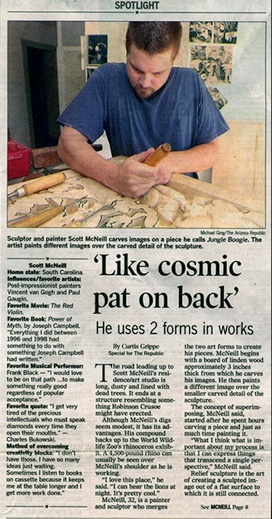Scott McNeill, “Like a cosmic pat on the back,” AZ Republic 2002

'Like Cosmic Pat On Back'
He uses 2 forms in works
By Curtis Grippe
Special for The Republic
June 21, 2002
The road leading up to Scott McNeill's residence/art studio is long, dusty and lined with dead trees. It ends at a structure resembling something Robinson Crusoe might have erected.
Although McNeill's digs seem modest, it has its advantages. His compound backs up to the World Wildlife Zoo's rhinoceros exhibit. A 4,500-pound rhino can usually be seen over McNeill's shoulder as he is working.
"I love this place," he said. "I can hear the lions at night. It's pretty cool."
McNeill, 32, is a painter and sculptor who merges the two art forms to create his pieces. McNeill begins with a board of linden wood approximately 3 inches thick from which he carves his images. He then paints a different image over the smaller carved detail of the sculpture.
The concept of superimposing, McNeill said, started after he spent hours carving a piece and just as much time painting it.
"What I think what is important about my process is that I can express things that transcend a single perspective," McNeill said.
Relief sculpture is the art of creating a sculpted image out of a flat surface to which it is still connected. McNeill specializes in bas relief, a shallow form of relief sculpture. He won a national award for bas relief sculpture from the National Sculpture Society, a body founded by the makers of the Lincoln Memorial.
McNeill joined the Peace Corps out of college and was sent to Honduras.
"I didn't join the Peace Corps to change the world, I joined hoping to find more time to paint, because I wanted to become a painter," McNeill said.
While living in Honduras, McNeill began learning the art of relief sculpture, ultimately buying his own set of handmade tools.
"Sculpting in wood or stone is much more technical," McNeill said. "It's pretty much one take. When you work with clay, you can fix mistakes, but you can't with wood or stone."
After five years in Honduras, McNeill returned to the states.
"When I first went to Honduras, I had a little culture shock, but it was nothing like coming home," he said. "I missed five years of popular culture. Fashion changed, terminology changed. My friends would say 'Let's go kick it,' and I didn't know what they were talking about. I really felt out of place."
McNeill began painting his sculptures early on.
"I was painting my pieces from the third or fourth piece I did," he said. "It was twice as much work, because you're basically starting a whole new piece as soon as you finish your sculpture, but it led me to what I'm doing now."
McNeill has had no problems selling his work and has done commissioned pieces, but ultimately he would like to present his work on a grander scale.
"I had a sold-out show about four years ago and from that show I got three or four commissions and met a few more people who ended up buying some of my work," he said. "I'm in a unique situation in that I live entirely off of my work without being in any local galleries, but it scares me because I don't have any kind of real solid thing. I do want to get myself out there, but I don't think that Scottsdale is the market that I should be in. I want to make big news with this stuff."
Meanwhile, his art will be on display at the West Valley Art Museum in December and continually on his Web site, www.scottmcneillart.com.








